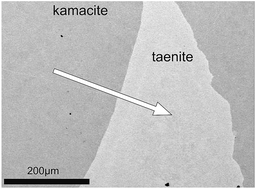In situ high-precision Ni isotope analysis of metals by femtosecond-LA-MC-ICP-MS†
Abstract
In this study, an in situ technique for high-precision determination of Ni stable isotope ratios by femtosecond-laser ablation-multicollector-ICP-MS (fs-LA-MC-ICP-MS) was developed. With this technique, the Ni isotope compositions of Ni-bearing steels (NIST RM-1226 and BAM D 184-1) and a Ni-rod (standard 10209 from MAC) were determined, both by fs-LA-MC-ICP-MS analyses and by solution MC-ICP-MS, the latter in order to verify the results of the in situ analyses. The LA-MC-ICP-MS analyses revealed that all analyzed standard materials were homogeneous within analytical uncertainties and may thus be suitable as external standards for Ni isotope determination by in situ analysis of metal phases and sulfides. Bulk solution MC-ICP-MS and LA-MC-ICP-MS analyses of these metals agreed within their analytical uncertainties of 0.03‰ for the solution analyses and <0.1‰ (2SD, over 12 months) for the LA-MC-ICP-MS analyses. These results imply that the accuracy of the in situ analyses of metals is better than 0.1‰. The average of four solution nebulization analyses of the Ni-rod and D 184-1, and of 16 analyses of the NIST RM-1226 material, revealed δ62Ni values of −0.26‰, 0.12‰, and −0.28‰ relative to NIST SRM-986, respectively. In order to show the applicability and potential of the presented method, the Ni and Fe isotope compositions of a kamacite–taenite interface in IAB iron meteorite Canyon Diablo were determined by fs-LA-MC-ICP-MS analyses. The isotope profile reveals lighter Fe isotopes in kamacite than in taenite, while the Ni isotope composition is vice versa. Evolution of the isotope signals along the interface of these metal phases strongly points to diffusion-driven fractionation of Fe and Ni isotopes during the formation of kamacite by the replacement of taenite. Due to Fe–Ni exchange diffusion between taenite and kamacite and the generally faster diffusion of light isotopes compared to heavy isotopes, the remaining taenite is left with heavier Fe and lighter Ni isotope compositions than the newly formed kamacite. Demonstration of such detailed information about the diffusion processes in the kamacite–taenite system was not possible before, due to the lack of an appropriate high-precision and high spatial resolution technique for in situ Ni isotope analyses.

- This article is part of the themed collection: JAAS Recent HOT articles


 Please wait while we load your content...
Please wait while we load your content...